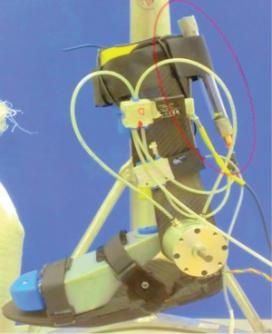Pneumatic Strain Energy Accumulator Exceeds Efficiency Over Traditional Actuation Methods
A strain energy accumulator was successfully demonstrated on an ankle foot orthosis (AFO) as a way to recover exhaust gas in a pneumatic system. The innovation emerged in research applications at the NSF-funded Engineering Research Center (ERC) for Compact and Efficient Fluid Power (CCEFP), headquartered at the University of Minnesota.
Use of the pneumatic strain energy accumulator resulted in an energy savings of over 25 percent compared to conventional operation of the AFO’s pneumatic actuation. This is an important milestone since the orthosis is representative of typical pneumatic actuator tasks. Industrial pneumatics consume roughly 0.5 percent of the energy in the United States; therefore, applications of the pneumatic strain energy accumulator for pneumatic devices on assembly lines could save between $1.4 and $2.5 billion dollars per year.
The typical method of pneumatic actuation is only 23 to 30 percent efficient, since a large amount of the energy is exhausted when the actuator changes direction. In contrast, the pneumatic strain energy accumulator developed at CCEFP is able to store a portion of this exhaust gas and then reuse it to assist the powered return motion of the actuator. A report from Oak Ridge National Laboratory, “Estimating the Impact (Energy, Emissions and Economics) of the U.S. Fluid Power Industry,” (published in December 2012) states that the recovery of exhaust gas from pneumatic systems could increase their efficiency by 14 to 23 percent. CCEFP’s demonstration on the AFO increased efficiency by 25 percent.


